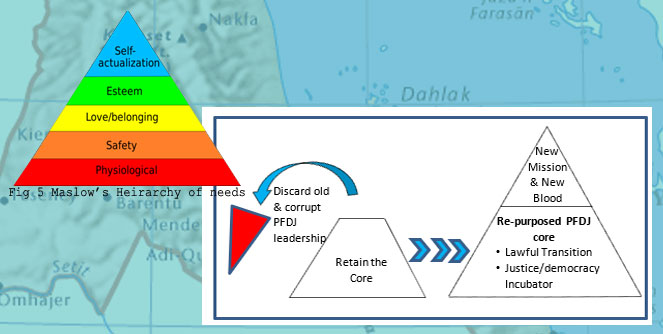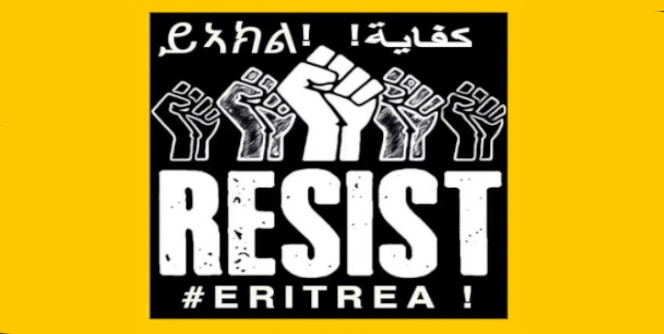Hgi Endaba: The Laws of our Ancestors
Megedi ArbiAa: Part I
In the small but highly diversified ethnic and cultural make up of the Eritrean population, there is something called Hgi Endaba which literally means the laws and or customs inherited from our ancestors. In the Christian/ Tygrina/highland population category, the word “Mother Land” is rarely used when referring to our country. This highly paternalistic and pecking order type of society does not allow the use of the term Motherland. I do not know well enough of the customs of the other ethnic groups to say definitively if same is true. So I will limit my essay to the customs of Christian Highlanders who inhabit the Seraye, Akeleguzay and Hamasien cultural regions.
The names that our forefathers gave to the highland regions have been radically obliterated by the administrative zoning of the current government. But I am not sure if the government has succeeded in emotionally alienating our people from Hgi Endaba. What we have now is Zoba Debub (Southern Zone), Zoba MaEkel (Central Zone) and Zoba Anseba which is quite different from our traditional “Endaba” zoning. I believe the government’s zoning is quite arbitrary and devoid of any logic although it is in keeping with its unrelenting effort to erase our cultural and religious heritage in prejudice to its socialist oriented political regimentation and acculturation. And the reason I am saying this is because I just found out that the village where I was born and three neighboring villages, which according to Hgi Endaba used to belong to one region are now spread out over three different regions.. As a result, some villagers have to make a long detour through Asmara to get to their designated administrative precincts. Why I asked? And my informant told me that contrary to Hgi Endaba, the government zones villages according to where their streams flow (KuO Mai). This particular doctrine apparently seems to have been adopted from Hgi Endaba. But the intention of the KuO Mai doctrine (following the flow of streams) in our traditional law was never meant for zoning purposes. It was one of the wise doctrines our forefathers applied to settle land disputes among villages. For example, if there are two villages on either side of a mountain, the apex of the mountain is normally taken as the boundary between these two villages. This traditional law was used as a deterrent for frivolous claims of land for centuries.
That said, I will concentrate on one of the most remarkable “Endaba” doctrines which facilitated the safe passage of travelers’ from point A to point B in traditional Eritrea. And this law is called “Megedi ArBeA” literally translated as “the Road of a caravan of forty “. In highland culture the number forty is used in different contexts. We have “Megedi ArBea, (road for forty), “Wedi ArBEa” and etc… “Megedi ArBea” is used in two contexts. One is to denote an area designated by each village for the safe passage of travelers passing through their village. The other context is to describe the habits of an intrusive personality. For example, if a person comes to visit you more frequently than seems to be reasonable, one may describe such a scenario by saying “Ngezay Ember Megedi ArBea AwTiEilu”, literally meaning, “he turned my house into an expressway by coming too frequently and uninvited”.
According to Hgi Endaba, each village has to provide a free passage for oncoming traffic of people and cattle. In this trail , travelers and their herd of cattle or sheep have the right of way. No barriers (HaTsur ..fence) could be placed there. So, what happens when this trail (Megedi ArbeA) is obstructed? Don’t tell me they will call Highway Patrol? The travelers can go and file their complaints with the appropriate village Chief (ChiKa Shum). The chief will immediately investigate to identify the culprit who blocked the Megdi Arbea and fine him. And he will make sure that the trail is re-opened again for through traffic. It would not be an exaggeration to say that the Europeans might have copied the very concept of the “highway” from our wise ancestors. Just as I have no doubt that the tonic in European music might have been copied from African beats. Long time ago, I went on a tour to Lake Abayata in Ethiopia when I noticed four peasant women returning from the lake where they drew their water and bringing their fills by balancing their water pots on their heads. On their way, they were singing a song which sounded to me like a quartet in four different tones viz melody, alto, tenor and base. “Wait a minute” I said, “how did they do it, which music school did they go to to learn their scales?” . After some thoughtful moments, I said to my self, “Possibly, the Europeans who organized musical sounds into written music might have heard these African sounds. It cannot be sheer coincidence?”
More often than not, however, we Africans fail to recognize that our forefathers have probably contributed significantly to human civilization. And we have a lot of cynical writers , like Aklilu Zere, who often portray our people as “hardy people” who have been tattering in poverty and subsistence since time immemorial. Such writers discribe our people as ones who are too over occupied with their mere biological needs to have any leisure time left to think of lofty ideals. And this kind of analogy is mostly based on the grim economic standing of African people in post colonial Africa often overlooking the fact that our bare and deforested soils are a result of colonial exploitation and neglect. There are still some Eritreans who are old enough to remember that most of Highland Eritrea was wooded until the Italians run their saws on our trees and the people cut the remaining for fire wood without any form of forestry/environmental supervision. A rampage of exploitative colonial anarchy is accountable for raking our trees and rich top soils.
Aklilu Zere described our highland people as miserable people who feed on chickpeas and meeting these people is like meeting “stones” and boulders. Many people may find such characterization amusing or educating. I wish to be an exception on this. If we were to take Akliulu Zere’s description of the Highland people of Eritrea as fair and representative, we will wonder how this kebessa people (who are described by him as an environmentalist would describe an ’endangered specie’) managed to avoid the threat of extinction. Why do we have two million of such people, alive and kicking at the turn of the new millennium. There must be something wrong with Aklilu Zere’s story just as there was a lot of exaggeration in James Bruce’s expeditionary story about Ethiopia a couple of centuries ago. Bruce’s book was very thrilling to the British readers of his time until some other discoverer found out that most of Bruce’s book were make-believe accounts of the places he visited. Bruce was condemned posthumously, although his book had earned him some fame and favors in the British royal court while he was alive.
Similarly, when we read Aklilu Zere’s profiling of the Kebessa people, it is the stories that he did not tell about this proud people that is probably more important than his grim accounts. Although much of kebessa history has not been documented there are many conjectural references of these people that attest the fact that they have maintained one of the most remarkable and memorable social fabric in Africa that enabled them to survive meaningfully through out their history. For one thing, their land is not as desolate as Aklilu Zere describes it. What are we to say of the rich black cotton soil of Seraye, the rich wheat and potato fields of Hamasien and Aala? And speaking of scarcity of water, how is it that the rain falls of the kebessa are sustaining Eritrea’s urban centers like Asmara, Mendeferea, Adi Quala, Adi Keiyh, Dekemhare and other urban settlings which account for almost half of the Eritrean population? Or is Aklilu ready to tell us that water is being pumped from the lowlands to supply the above cities? What are we to say about the River Mareb and Ruba Anseba which are the lifeline of the lowlands and which get most of their water from Kebessa? Our James Bruce, tells us highlanders do not wash their hands after meals in order to save water. Is this story line credible or shall we dismiss is as something sinister that is written to ridicule the people? By the way how much water can be saved this way? I will leave the answer to the reader.
Lastly, I like to point out that Aklilu Zere’s profiling of the highland people is not something new. Those of us who have lived in Ethiopia for most of our lives are standing witnesses as to how the other “Aklilus ” in feudal Ethiopia used to demean our people by tagging such derogatory labels as “Anbeta Belita” (locust eaters), “Tchigaram Tigre” miserable Tygrinas and what have you. That was intended to make us feel inferior and put a dent on our political resolve for the struggle for freedom. However, their dreams never materialized. Our people have survived for millions of years and will continue to survive.
Our peoples’ greatest challenge is not the lack of what to eat or drink as Aklilu Zere would want us to believe, but the lack of a viable and just system of governance. The current government is waging a war on our heritage, Hgi Endaba, and hurting our people in a big way. Restoring the wisdom of our fathers and our Higi Endaba , which undoubtedly have been the reason for our survival as civil society, should be part of our long running struggle against tyranny and the cynicism and ridicule penned by such unscrupulous writers such as Lij Aklilu Zere.
…to be continued



Awate Forum